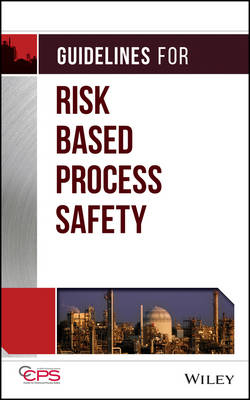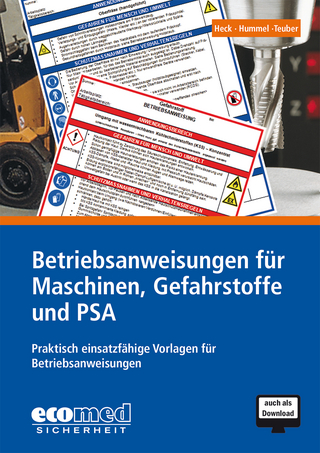
Guidelines for Risk Based Process Safety
Wiley-Blackwell (Hersteller)
978-0-470-92511-9 (ISBN)
- Keine Verlagsinformationen verfügbar
- Artikel merken
Guidelines for Risk Based Process Safety provides guidelines for industries that manufacture, consume, or handle chemicals, by focusing on new ways to design, correct, or improve process safety management practices. This new framework for thinking about process safety builds upon the original process safety management ideas published in the early 1990s, integrates industry lessons learned over the intervening years, utilizes applicable "total quality" principles (i.e., plan, do, check, act), and organizes it in a way that will be useful to all organizations - even those with relatively lower hazard activities - throughout the life-cycle of a company.
Since 1985, the Center for Chemical Process Safety (CCPS) has been the world leader in developing and disseminating information on process safety management and technology. CCPS, an industry technology alliance of the American Institute of Chemical Engineers (AIChE), has published over 80 books in its process safety guidelines and process safety concepts series.
List of Tables. List of Figures. Acronyms and Abbreviations. Glossaiy. Acknowledgments. Preface. Executive Summaiy. Purpose of These Guidelines. Background. Important Terminology. Management Systems Concepts. Risk Based Process Safety Elements. Relationship Between RBPS Elements and Work. Activities. Application of these RBPS Guidelines. Organization of these Guidelines. References. 2 OVERVIEW OF RISK BASED PROCESS SAFETY. 2.1 fisk Based Process Safety System Design Strategies. 2.2 Risk Based Process Safety Design and Improvement Criteria. 2.3 Using Element Chapters to Design and Improve a Process Safety Management System. 1 COMMIT TO PROCESS SAFETY. 3 PROCESS SAFETY CULTURE. 3.1 Element Overview. 3.2 Key Principles and Essential Features. 3.3 Possible Work Activities. 3.4 Examples of Ways to Improve Effectiveness. 3.5 Element Metrics. 3.6 Management Review. 3.7 References. 4 COMPLIANCE WITH STANDARDS. 4.1 Element Overview. 4.2 Key Principles and Essential Features. 4.3 Possible Work Activities. 4.4 Examples of Ways to Improve Effectiveness. 4.5 Element Metrics. 4.6 Management Review. 4.7 References. 5 PROCESS SAFETY COMPETENCY. 5.1 Element Overview. 5.2 Key Principles and Essential Features. 5.3 Possible Work Activities. 5.4 Examples of Ways to Improve Effectiveness. 5.5 Element Metrics. 5.6 Management Review. 5.7 References. 6.1 Element Overview. 6.2 Key Principles and Essential Features. 6.3 Possible Work Activities. 6.4 Examples of Ways to Improve Effectiveness. 6.5 Element Metrics. 6.6 Management Review. 6.7 References. 7 STAKEHOLDER OUTREACH. 7.1 Element Overview. 7.2 Key Principles and Essential Features. 7.3 Possible Work Activities. 7.4 Examples of Ways to Improve Effectiveness Actions. 7.5 Element Metrics. 7.6 Management Review. 7.7 References. 1 I UNDERSTAND HAZARDS AND RISK. 8.1 Element Overview. 8.1.1 WhatIsIt? 8.1.2 Why Is It Important? 8.1.3 Where~WhenIs It Done? 8.1.4 Who Does It? 8.1.5 What Is the Anticipated Work Product? 8.1.6 How Is It Done? 8.2 Key Principles and Essential Features. 8.3 Possible Work Activities 8.4 Examples of Ways to Improve Effectiveness. 8.5 Element Metrics. 8.6 Management Review. 8.7 References. 9 HAZARD IDENTIFICATION AND RlSK ANALYSIS. 9.1 Element Overview. 9.2 Key Principles and Essential Features. 9.3 Possible Work Activities. 9.4 Examples of Ways to Improve Effectiveness. 9.5 Element Metrics. 9.6 Management Review. 9.7 References. 1 0 OPERATING PROCEDURES. 10.1 Element Overview. 10.2 Key Principles and Essential Features. 10.3 Possible Work Activities. 10.4 Examples of Ways to Improve Effectiveness. 10.5 Element Metrics. 10.6 Management Review. 10.7 References. 1 1 SAFE WORK PRACTICES. 1 1.1 Element Overview. 1 1.2 Key Principles and Essential Features. 1 1.3 Possible Work Activities. 1 1.4 Examples of Ways to Improve Effectiveness. 1 1.5 Element Metrics. 1 1.6 Management Review. 1 1.7 References. 1 2 ASSET INTEGRITY AND RELIABILITY. 12.1 Element Overview. 12.2 Key Principles and Essential Features. 12.3 Possible Work Activities. 12.4 Examples of Ways to Improve Effectiveness. 12.5 Element Metrics. 12.6 Management Review. 12.7 References. 1 3 CONTRACTOR MANAGEMENT. 13.1 Element Overview. 13.2 Key Principles and Essential Features. 13.3 Possible Work Activities. 13.4 Examples of Ways to Improve Effectiveness. 13.5 Element Metrics. 13.6 Management Review. 1 3.7 References. 1 4 TRAINING AND PERFORMANCE ASSURANCE. 14.1 Element Overview. 14.2 Key Principles and Essential Features. 14.3 Possible Work Activities. 14.4 Examples of Ways to Improve Effectiveness. 14.5 Element Metrics. 14.6 Management Review. 14.7 References. 1 5 MANAGEMENT OF CHANGE. 15.1 Element Overview. 15.2 Key Principles and Essential Features. 15.3 Possible Work Activities. 15.4 Examples of Ways to Improve Effectiveness. 1 5.5 Element Metrics. 15.6 Management Review. 1 5.7 References. 16.1 Element Overview. 16.1.6 How Is It Done? 16.2 Key Principles and Essential Features. 16.3 Possible Work Activities. 16.4 Examples of Ways to Improve Effectiveness. 16.5 Element Metrics. 1 6.6 Management Review. 16.7 References. 1 7 CONDUCT OF OPERATIONS. 17.2 Key Principles and Essential Features. 17.3 Possible Work Activities. 17.4 Examples of Ways to Improve Effectiveness. 17.5 Element Metrics. 17.6 Management Review. 1 7.7 References. 18.1 Element Overview. 18.2 Key Principles and Essential Features. 18.3 Possible Work Activities. 18.4 Examples of Ways to Improve Effectiveness. 18.5 Element Metrics. 18.6 Management Review. 1 8.7 References. IV LEARN FROM EXPERIENCE. 1 9 INCIDENT INVESTIGATION. 19.1 Element Overview. 19.2 Key Principles and Essential Features. 19.3 Possible Work Activities. 19.4 Examples of Ways to Improve Efficiency and Effectiveness. 19.5 Element Metrics. 19.6 Management Review. 1 9.7 References. 20 MEASUREMENT AND MCTRlCS. 20.1 Element Overview. 20.2 Key Principles and Essential Features. 20.3 Possible Work Activities. 20.4 Examples of Ways to Improve Effectiveness. 20.5 Element Metrics. 20.6 Management Review. 20.7 References. 2 1.1 Element Overview. 2 1.2 Key Principles and Essential Features. 2 1.3 Possible Work Activities. 2 1.4 Examples of Ways to Improve Effectiveness. 2 1.5 Element Metrics. 2 1.6 Management Review. 2 1.7 References. 22 MANAGEMENT REVIEW AND CONTlNUOUS IMPROVEMENT. 22.1 Element Overview. 22.2 Key Principles and Essential Features. 22.3 Possible Work Activities. 22.4 Examples of Ways to Improve Effectiveness. 22.5 Element Metrics and Indications. 22.6 Management Review. 22.7 References. 23.1 Reasons to Implement a Risk-based Process Safety Management System. 23.2 First Steps Toward Implementation. 23.3 Start with RBPS Elements that Provide the Greatest Risk Benefit to Your Facility. 23.4 Implementation Examples. 23.5 Other Applications. 23.6 Conclusions. 23.7 References. INDEX.
| Erscheint lt. Verlag | 26.8.2010 |
|---|---|
| Verlagsort | Hoboken |
| Sprache | englisch |
| Maße | 161 x 240 mm |
| Gewicht | 1142 g |
| Themenwelt | Naturwissenschaften ► Chemie ► Technische Chemie |
| Technik | |
| Wirtschaft | |
| ISBN-10 | 0-470-92511-6 / 0470925116 |
| ISBN-13 | 978-0-470-92511-9 / 9780470925119 |
| Zustand | Neuware |
| Haben Sie eine Frage zum Produkt? |
aus dem Bereich
